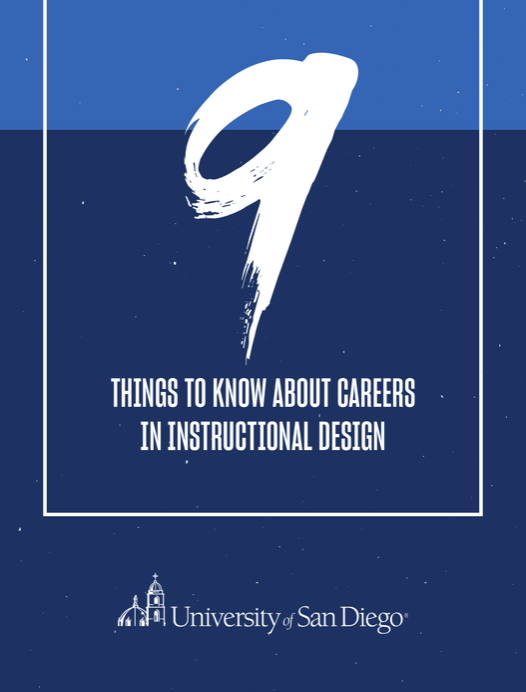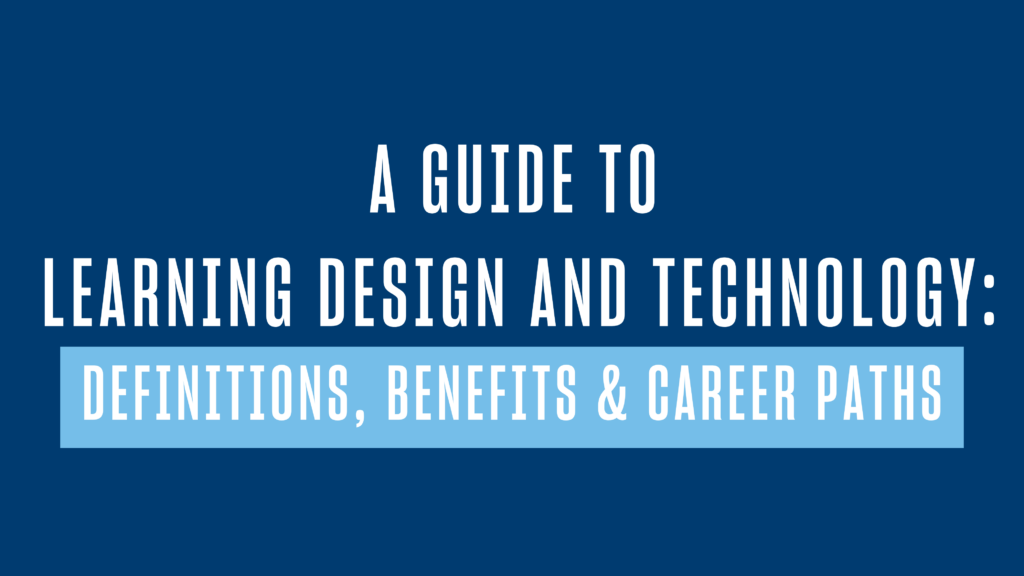Organizations across the business world, government and higher education are looking for talented learning designers who possess the experience, academic background and aptitude to design effective and engaging instructional materials.
These learning design career opportunities come with a range of different job titles, salaries and responsibilities — and the list of well-known and lesser-known organizations now hiring learning designers may surprise you.
But there is at least one common denominator: Those who have a comprehensive understanding of the models and theories that form the foundation of learning design, and who are also familiar with related technology tools, are currently in high demand across the employment landscape.
Read on for a closer look at a range of well-paying learning design and technology career opportunities, along with salaries and a glimpse into which companies are hiring for these roles. But first a bit of background about this fascinating, fast-growing field:
What is Learning Design?
The term learning design is often used interchangeably with instructional design, as well as learner experience design. There are several important differences, but fundamental to both learning design and instructional design is the practice of creating instructional materials and learning experiences that enable people to acquire and retain new knowledge and skills. Such work is best performed by professionals who have a thorough understanding of established models and theories rooted in the science of how people learn.
A clue to the key difference between learning design and instructional design is found in their respective titles. Instructional design, a discipline that traces its roots to the U.S. war effort during World War II, was initially focused on the teaching activity, i.e., the instruction. As the field evolved, learning design and learner experience design came to represent the idea that it is important to place a more deliberate focus on understanding how the instructional materials best connect to the unique attributes and experiences of the target audience, i.e., the learner.
The distinction between learning design careers and instructional design careers is not front and center in the employment market. For example, a recent search for “learning designer” on LinkedIn and Indeed also revealed listings for “instructional designer” jobs and related titles.
Top Learning Design-Related Careers
Learning design-related jobs can be found under a range of different titles. Here, we’ll examine several of the most common ones, along with common job responsibilities and a look at what companies and organizations are hiring under each job title.
This report will also include estimated salary figures; however, it is important to note that salary estimates tend to vary considerably because different methodologies are used and because figures are often adjusted in real time based on changing data. A recent survey by instructional design blogger and consultant Devlin Peck revealed an average salary for U.S. instructional designers of $83,144.
[RELATED RESOURCE] Want to explore your career options? Discover how instructional design can fit your goals.
Learning Designer | Instructional Designer | Learning Experience Designer
Despite the subtle differences mentioned above, these job titles are also often used interchangeably. Excelling in the field of learning design requires proficiency in key technology tools (more on this below), and also in the theories and best practices that provide the framework for using such tools to create meaningful and highly effective learning experiences.
Companies hiring for these job titles in a recent search:
- Learning Designer: Humana, LeapFrog, Multiverse, BetterLesson
- Instructional Designer: Facebook, HubSpot, Chewy, MIT, Amazon, Apple, McKinsey
- Learning Experience Designer: Amazon, Coinbase, Duke University, TikTok, Uber
Salary estimates (median-high):
- Learning Designer: $72,587–$98,000 (Glassdoor)
- Instructional Designer: $76,790–$93,000 (Salary.com)
- Learning Experience Designer: $90,513-$107,189 (Salary.com)
Senior Instructional Designer | Instructional Design Manager
Higher-level positions such as senior instructional designer and instructional design manager are typically held by experienced IDs/LDs who have all of the foundational skills but also possess strong project management and leadership capabilities. They typically hold a master’s degree in learning design or a related discipline.
Companies hiring for these job titles in a recent search:
- Senior Instructional Designer: MathWorks, Amazon, Apple, JetBlue, AAA, Cognizant, Wendy’s, Charles Schwab, UPenn
- Instructional Design Manager: Facebook, Medtronic, Envision Pharma, KPMG, Amazon, 3M, McDonald’s
Salary estimates (median-high):
- Senior Instructional Designer: $95,000–$116,000 (Salary.com)
- Instructional Design Manager: $110,000-$138,000 (Salary.com)
Instructional Technologist | Educational Technologist
These two closely related roles, commonly but not exclusively found in academic settings, are ideal for someone who has some experience installing, maintaining and troubleshooting instructional hardware and software, and perhaps helping to train users on how to incorporate technology into lesson planning. A common path for those working in these roles, especially those who are inspired as much by the educational element as the technology component, is to branch out into learning design-related roles.
Companies hiring for these job titles in a recent search:
- Instructional Technologist: Brown University, University of Hawaii, Endicott College, TripAdvisor, Edward Jones
- Educational Technologist: Columbia University, University of Miami, Ohio State University, Sotheby’s
Salary estimates (median-high):
- Instructional Technologist: $63,000–$87,000 (Glassdoor)
- Educational Technologist: $61,500–$89,000 (Glassdoor)
eLearning Developer | Training Specialist
Commonly found in corporate settings, and sometimes called an eLearning specialist or corporate trainer, these roles are often held by professionals who prepare instructional materials and programs for onboarding or job-related training. People in this role often benefit from learning more about design fundamentals and tech tools; for example, subject matter experts who train people but discover they would also like to have more control over designing the learning experience.
Companies hiring for these job titles in a recent search:
- eLearning Developer: Amazon, Sun River Health, TTi Global, Seegrid, Equifax
- Training Specialist: Pearson, Central Intelligence Agency, Anthem, Tesla
Salary estimates (median-high):
- eLearning Developer: $76,000–$93,000 (Salary.com)
- Training Specialist: $67,000–$85,000 (BLS.gov)
Other Learning Design-Related Job Titles
In addition to the positions detailed above, there is a wide range of job titles for those working in learning design and related disciplines, including:
- Learning Strategist
- Educational Consultant
- Learning Strategies Director
- eLearning Designer
- eLearning Specialist
- eLearning Consultant
- eLearning Project Manager
- Content Developer
- Curriculum Coordinator
- Curriculum Developer
- Chief Learning Officer
Top Learning Design Technology Tools
One of the best and most widely used tools in the field of learning design is the Articulate 360 suite, which includes Storyline 360 and Rise 360. Articulate Founder and CEO Adam Schwartz explains in a video that the software subscription “empowers you to create any interactive eLearning course you can imagine for any device imaginable, from desktop and laptop computers to tablets and smartphones.”
Another leading instructional design software tool is Adobe Captivate (see video), described by the company as “an all-in-one solution for creating incredible eLearning that meets the needs of your on-the-go audience.”
Professionals working in learning design and related disciplines have a wide variety of additional technology tools to choose from when creating instructional materials. Some of the most notable are listed below:
- Adobe Photoshop and Illustrator
- PowerPoint
- Camtasia
- Canva
- Gimp
- Lectora
- SoftChalk CloudFaster Course
- XMind
- SAP Litmos
- Spring
[FREE GUIDE] Thinking about joining this field? See how instructional design offers exciting growth opportunities.
What Does a Learning Design and Technology Master’s Degree Teach You?
As is true of many professions, a comprehensive grasp of the core knowledge, skills and abilities is essential in the field of learning design. Among the many benefits of earning your master’s in learning design or instructional design, you can expect to build practical skills that are widely sought after across nearly all industries.
For example, in the online Master of Science in Learning Design and Technology degree program offered by the University of San Diego, students develop a comprehensive understanding of the science of how people learn. Students also gain proficiency in the leading technology tools currently used in instructional/learning design, with a particular focus on Articulate 360.
Throughout the 20-month program, you will also create an online portfolio you can use to showcase your skills to potential employers and build a professional network that supports lifelong learning in this fascinating and fast-growing field. A survey of 853 instructional design professionals indicates that as many as 87% of instructional designers have earned a master’s degree.
Learning Design and Technology Career Resources
The world of learning design and technology features an engaged and supportive online community of industry professionals who are eager to share information and ideas.
These include learning design bloggers/consultants such as:
- Cathy Moore
- Christy Tucker
- Clark Quinn (Quinnovation)
- Connie Malamed
- Devlin Peck
- Julie Dirksen (Usable Learning)
- Karl M. Kapp (Kapp Notes)
- Luke Hobson
And LD/ID communities such as:
- E-Learning Heroes – a community sponsored by Articulate
- Instructional Design Central – LinkedIn group hosted by industry advocate IDC
FAQs About Learning Design and Technology Careers
Q: Why is learning design and technology such an in-demand career field today?
A: Partly in response to both COVID-19 and other economic trends, organizations throughout private industry and government are handling more and more of their employee training online. Educational institutions are also greatly expanding their emphasis on virtual and online offerings.
Q: How much do instructional designers get paid?
A: Salary information from employment websites shows annual pay starting in the $65K range and tracking much higher depending on the employer and the level of responsibility. Figures are subject to change as new data comes in, but here is a sampling of instructional designer salary ranges as of the publication of this report:
- ZipRecruiter lists an average salary of $80,182, ranging up to $132,500
- Glassdoor lists an average salary of $70,173, ranging up to $100,000
- Salary.com lists an average salary of $76,690, ranging up to $93,120
Q: How accessible is the field of learning design to career changers?
A: Very. Thanks to the growing need for professionals with learning design and technology skills, it is expected that a significant number of future learning designers will come from a range of other life experiences, professional backgrounds and areas of expertise. Graphic designers, teachers and corporate trainers, for example, are among several types of professionals who are well-positioned to transition into instructional design.
The report is brought to you by the University of San Diego’s career-building, online Master of Science in Learning Design and Technology degree program.

![Top Jobs and Careers in Learning Design and Technology [+ Salary Info]](https://onlinedegrees.sandiego.edu/wp-content/uploads/2021/08/ldt_blog_topjobsld.png)



![Preview image of What is Instructional Design? [5 Examples + Overview]](https://onlinedegrees.sandiego.edu/wp-content/uploads/2021/08/ldt_blog_whatisid-1024x576.png)